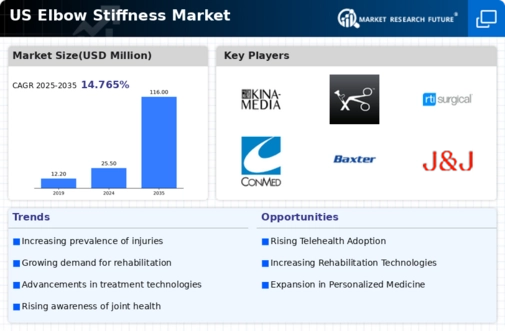The competitive insights of the US Elbow Stiffness Market reveal a landscape characterized by innovation, strategic partnerships, and a diverse range of products aimed at addressing elbow-related conditions. With a growing prevalence of elbow stiffness attributed to factors such as aging populations, sports injuries, and various health conditions, the market has witnessed substantial interest from key players seeking to enhance their product offerings. Companies in this segment are investing in research and development to introduce advanced treatment options, leveraging technology to improve the overall outcomes for patients dealing with elbow stiffness.
Furthermore, industry players are engaging in strategic collaborations and acquisitions to expand their market reach and strengthen their competitive positioning, indicating a dynamic atmosphere where adaptability is crucial for success.
Smith and Nephew has established a significant presence in the US Elbow Stiffness Market, benefiting from its well-known reputation and extensive portfolio of medical devices. The company's strengths lie in its innovative product offerings, which focus on orthopedic solutions designed to improve mobility and reduce pain associated with elbow stiffness. Well-recognized for their advanced surgical instruments and rehabilitation solutions, Smith and Nephew continuously strives to address the needs of surgeons and patients through extensive research and development efforts.
Their commitment to quality and customer satisfaction has earned them a competitive edge, allowing them to effectively respond to the evolving demands of healthcare professionals in the US while solidifying their position as a leader in the orthopedic market.
Kinamed, while relatively smaller compared to industry giants, has carved out a niche for itself in the US Elbow Stiffness Market through its specialized offerings and expertise in orthopedic solutions. The company develops innovative products specifically targeted at soft tissue repair and implant technologies, catering to the needs associated with elbow stiffness and related conditions. Kinamed's strengths include its focus on high-quality surgical products and its dedication to enhancing patient outcomes, which has contributed to its growing market presence.
The company has adopted strategic approaches to mergers and acquisitions, allowing it to expand its capabilities and offer a wider range of services. By continuously striving for innovation and leveraging its unique position in the market, Kinamed remains a key player in addressing the complexities of elbow stiffness within the US healthcare landscape.





















